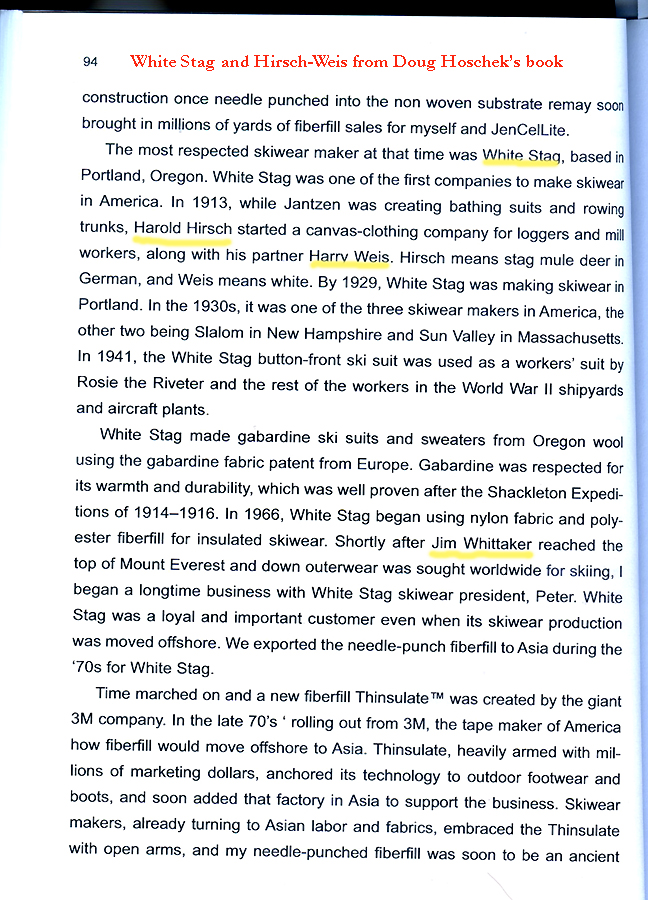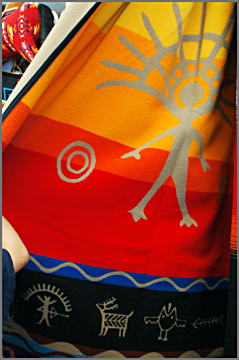

In the image you see a Native America motif; it is very similar to some petroglyphs I have seen in the Columbia River Gorge east of The Dalles..The largest figure may represent a Spirit Quest..... I took this image inside the Pendleton Mill store in Washougal, Washington, on the western end of the Gorge.... The object pictured is a very large blanket of thick wool, that was hung with many others, all with wonderous motifs celebrating the long-term linkages between Pendleton Woolen Mills and the Native American culture of the Pacific Northwest. It's a very honorable tradition. The Pendleton Indian blankets are still made in Pendleton....But I wonder how can Pendleton survive the 21 st. Century. How can it cope with the Far East? With the supremacy of synthetic-based fabrics? With waterproof-breatheable laminates? With a much more urban/fashion oriented clientele?
Pendleton Mills began in 1863--- To place this date in context within the overall History of Gear, this was seventy-five years before REI Coop was formed in Seattle! Of course, in 1863 "cowboy hats" were not just affectations, so in being true to the traditions of its roots, the Pendleton store has a good selection of quality cowboy hats.
.....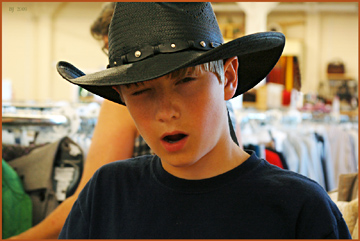 ....
....
PENDLETON HISTORY AND CURRENT OPERATIONS:
When Pendleton Woolen Mills opened, Oregon had only been a State for four years! The cold, wet climate provided an excellent long-term market selling wool clothing and blankets to generations of loggers, farmers, ranchers, Native Americans and townsfolk! Even the rise of the new-fangled wool replacement called "fuzz pile" during the 1980s and 90s failed to put this Northwest legend in the grave.
These Days, the main Pendleton facilities in our local area are split between the mill in Pendleton, Oregon, a "scouring mill" on North Columbia Blvd. in North Portland (click for more about this), a corporate headquarters/company store on Broadway in downtown Portland, another store and a distribution center in Milwaukie (Oregon), and the "Mill Store" in Washougal, which shares its grounds with the historic 1912 -built buildings of a Pendleton factory. But despite the fact that Pendleton remains an Oregon-based, and very family owned-operated business (The Bishop family remains in charge), it has far-flung stores and factories, eg. a major wool-washing plant in Texas, major sewing in Oklahoma, etc. ...Many Northern Oregon Customers now tend to associate the company with the sprawling store/factory just across the Columbia River from Portland, in Washougal, Washington (see below)....Go to my "Pendleton, page one."
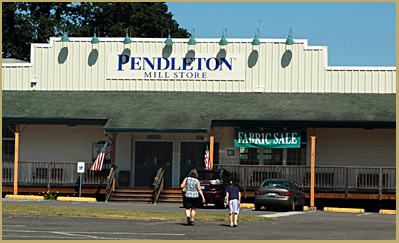
Please Note: All Material above, and in all my "History of Gear" webpages, is copyrighted, and no usage of my material is permitted unless explicit permission is granted by me, Bruce B. Johnson, owner of OregonPhotos.com. .. Editors: Please contact me if you have interest in publishing (brucej@oregonphotos.com) ....Others: if you were involved with one of the old-line, vintage gear companies and have a story to tell in these pages, please contact me soon.
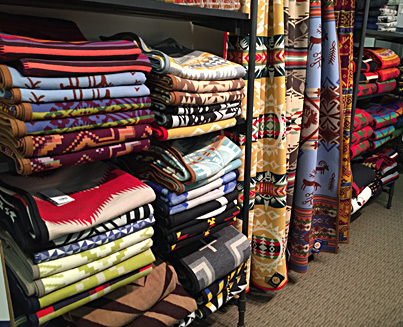
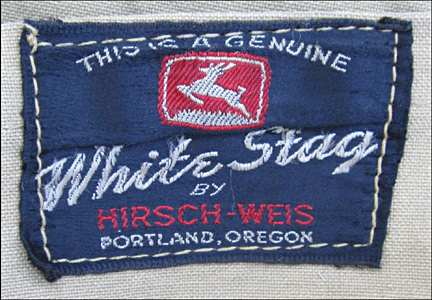
This Portland-based
garment company has a very long history. The Hirsch-Weis parent
company had roots back to around 1900 (accounts vary). One of
the founder's sons came back from college on the East Coast with
big ideas for ski clothing in 1929, and in 1931 the company put
out a ski suit under a label "White Stag," which is
literally the translation from the German of the two founders'
names! Eventually, White Stag also produced down sleeping bags,
and by the late 50s had a catalog with many outdoor camping items
such as tents. 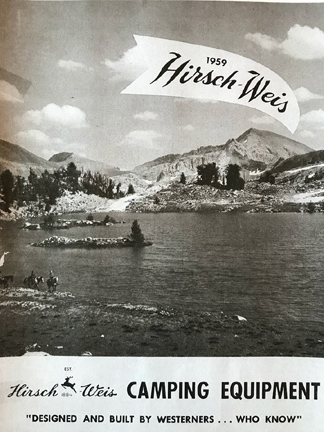 The
cover photo of their 1959 catalog is an all-Oregon affair: cover
picture by famed Oregon photographer Ray Atkeson, with the subject
being Glacier Lake in NE Oregon, with a horse pack train on its
shores. Glacier Lake is in the Wallowa Mountains in NE Oregon
near Hells Canyon.
The
cover photo of their 1959 catalog is an all-Oregon affair: cover
picture by famed Oregon photographer Ray Atkeson, with the subject
being Glacier Lake in NE Oregon, with a horse pack train on its
shores. Glacier Lake is in the Wallowa Mountains in NE Oregon
near Hells Canyon.
Portland's
famous White Stag sign: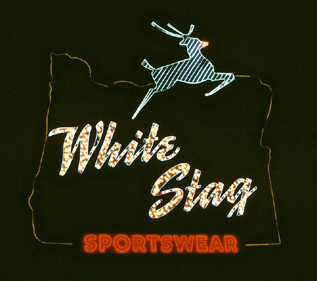 In 1957, the company modified a large animated sign on the roof
of its downtown Portland building next to the Burnside Bridge
to include a stag deer leaping over an outline of the state of
Oregon. For the 1959 Christmas season, a red neon "nose"
was added to the stag's snout in imitation of Rudolph the Red-Nosed
Reindeer, a tradition that was repeated every Christmas (picture
by Steve Morgan). The White Stag sign quickly became an identifying
landmark for the city, and it was designated a Portland landmark
by the city's Historic Landmarks Commission in 1977.
In 1957, the company modified a large animated sign on the roof
of its downtown Portland building next to the Burnside Bridge
to include a stag deer leaping over an outline of the state of
Oregon. For the 1959 Christmas season, a red neon "nose"
was added to the stag's snout in imitation of Rudolph the Red-Nosed
Reindeer, a tradition that was repeated every Christmas (picture
by Steve Morgan). The White Stag sign quickly became an identifying
landmark for the city, and it was designated a Portland landmark
by the city's Historic Landmarks Commission in 1977.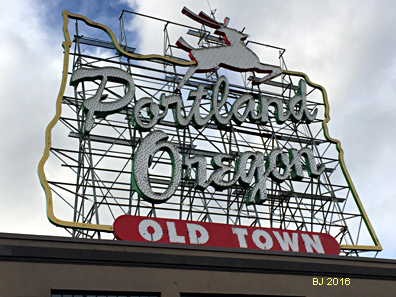 After a 40-year run, the "White Stag" part of the well-known
sign was altered and in recent years just says "Portland
Oregon" under the leaping stag deer.
After a 40-year run, the "White Stag" part of the well-known
sign was altered and in recent years just says "Portland
Oregon" under the leaping stag deer.
In its later stages, 1986, White Stag had around 200 employees, and its facilities included a three-building complex occupying 14 acres on S.E. Harney Drive in Southeast Portland. In 1983, its annual sales were reported at 70 million dollars. Sometime in the late 80s, White Stag came under fire, and the company that owned it went backrupt in 2003, after which the label/name were bought by Walmart. No more worthy ski-outdoor clothing was made. White Stag's history essentially had ended around 1986. Skip to Doug Hoschek's account about the company from his 2011 book "Polar Pollution," 239 pages (click here).
